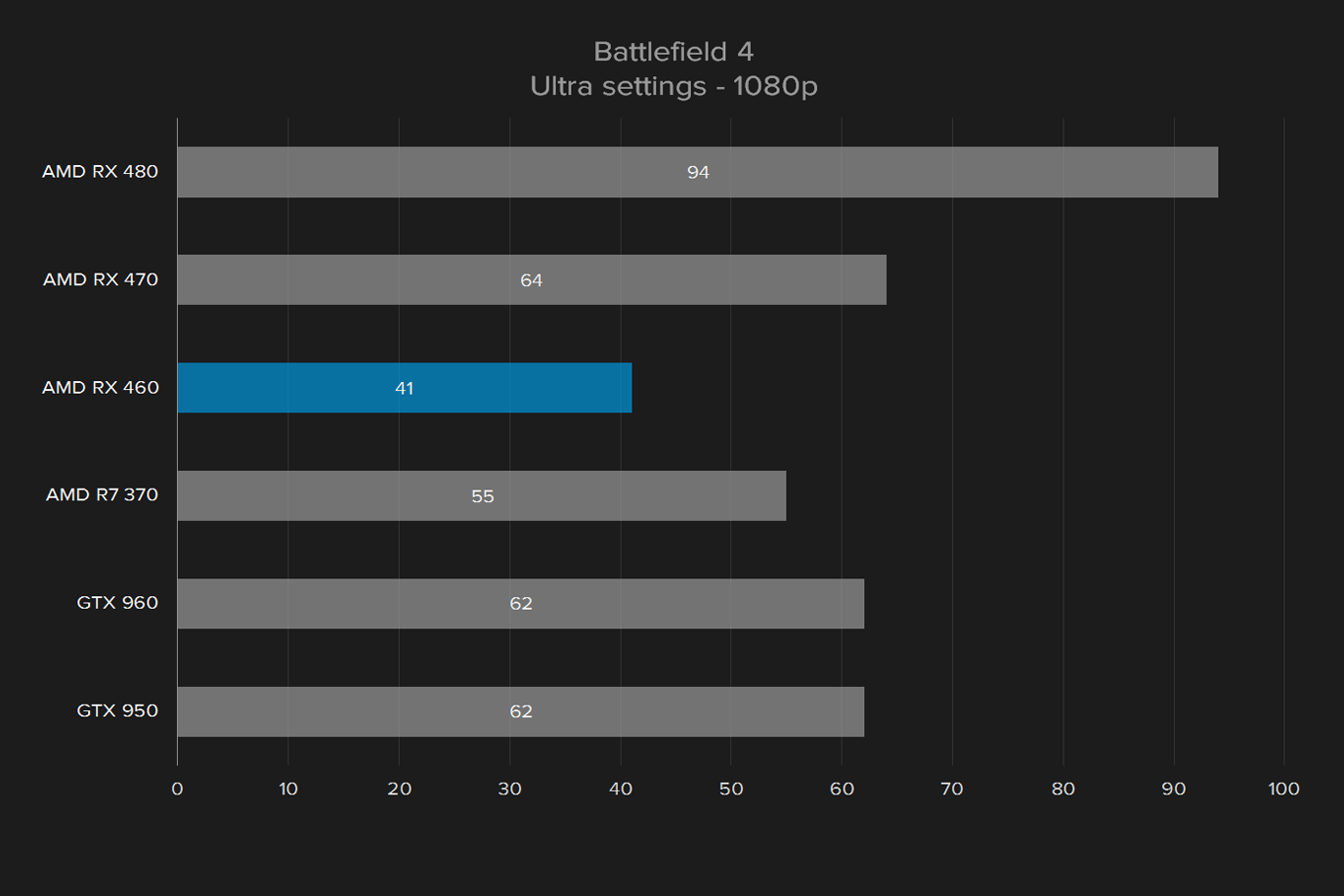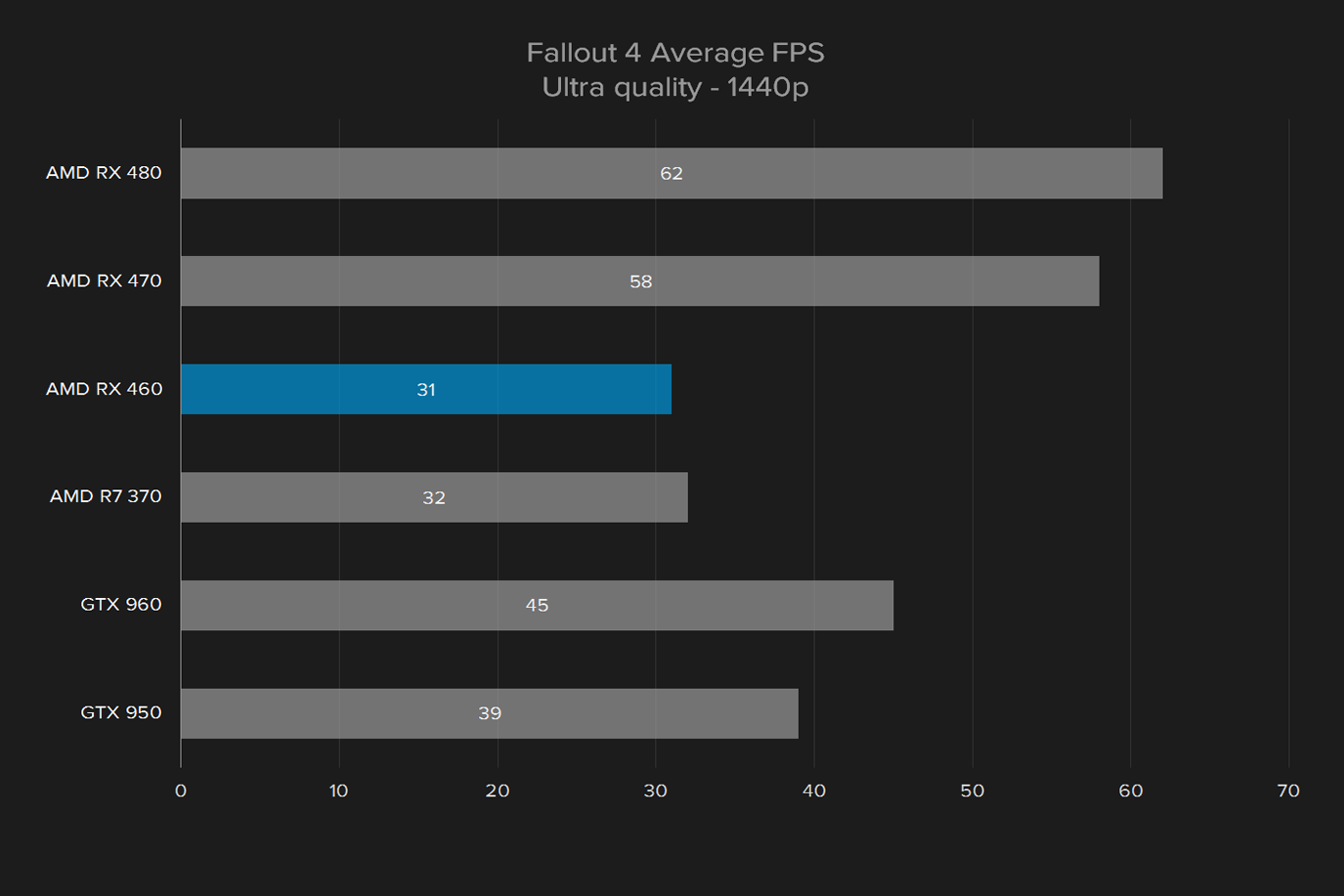- As feature-packed as more expensive Radeons
- Fast enough for 1080p in many games
- Compact size
- Performance has limits, even at 1080p
At the PC Gaming Show in 2015, AMD rolled out the high-end Fury cards. Meant to compete with Nvidia’s 980 Ti, the card came up short. This time around, AMD is refocusing the Radeon line on a market the red team has won over before – builders on a budget.
The top-end RX 480 starts at just $200, and is well equipped for VR and 1440p gaming. The RX 470 starts at $179 and more than holds its own at 1080p. The RX 460, meanwhile, is marketed for “eSports gaming.” That’s may seem vague, but it’s a clear reference to titles like League of Legends and Counter-Strike: Global Offensive. These games prioritize high framerates over brilliant graphics.
In any case, the wallet-friendly RX 460 is pushing the bottom end for modern GPUs. At just $109, the RX 460 is about as inexpensive as video cards get before they lose any gaming credibility. Our Sapphire model, with an extremely modest overclock and 4GB of memory, retails at $139.
Is this new card a legitimate choice for players lacking cash, or does is deliver too little even for its bottom-dollar pricing?
A numbers game
AMD’s new platform, Polaris, marks Radeon’s move to a smaller 14-nanometer manufacturing process, as well as the switch from flat transistors to FinFET 3D transistors. We’ll spare you the nitty-gritty, except to note the standout features are greatly improved power efficiency, which results in a 75-watt thermal design power, asynchronous compute support, and a high level of compatibility with both DirectX 12 and Vulkan games. If you’re interested in learning more about Polaris, our Radeon RX 480 review and introduction to the platform are a great place to start.
The RX 460’s particular flavor of the Polaris architecture sports 896 Stream Processors clocked at a 1,090MHz base clock, with a Boost Clock of up to 1,200MHz when thermals and power allows. Users will have a choice of either 2GB or 4GB of 128-bit GDDR5 memory, for a total of 112GBps of memory bandwidth.
Our review unit was a 4GB Sapphire Nitro with a slight overclock to 1,175MHz base and 1,250MHz boost. Despite the technically low-enough thermal design power, it also sports a six-pin PCIe power connection. Technically, the RX 460 can run without an external PCI power connection. That’s great for gamers who have an extremely basic rig, and can’t afford to upgrade the power supply.
The RX 470 and 480 boast at least 2,000 Stream Processors each, and 200 GBps of memory bandwidth, or higher. The RX 460 basically sits at less than half, although its clock speed is higher than the RX 470. On paper, then, its performance looks a lot different than its more expensive cousins.
Its feature set, however, matches the higher-end cards. That means EyeFinity, FreeSync, Crossfire, and DirectX 12.
Performance
We tested the Radeon RX 460 in our X99 test system. With an Intel Core i7-6950X, 8GB of RAM, and an Intel 750 Series SSD, our rig is clearly much more powerful than you’d usually expect to see alongside this budget GPU. The upshot to this is that the card will be able to hit its full potential without the CPU bottlenecking it.
So, how does it perform?
The RX 460 average about 46 percent of the RX 480’s performance in the synthetic 3DMark test. That score means it trades blows with the previous generation’s Radeon R7 370, a 2GB card that sits right around $140. That isn’t the most impressive score ever, but it certainly beats out integrated graphics options several times over. It’s also essentially tied with the GTX 960 in the Alienware Alpha R2, which is likely a underclocked version of the GPU, given the Alpha’s small size and power limitations.
We typically consider 60 frames per second to be the goal for most gaming machines, and the RX 460 certainly falls short of that in modern, demanding games, at least with the graphics turned up. Counter-Strike: Global Offensive runs quite well, though, and that’s certainly an eSports-focused game, even if it is a little on the old side.
On the other hand, the RX 460 performs much more admirably with the settings turned down a bit. It averages 62 FPS in Fallout 4, and 123 FPS in Battlefield 4, at medium settings. Most users don’t have the luxury of being able to crank the settings up in every game, and neither will RX 460 owners – but this video card can indeed play modern titles at respectable framerates.
Without hitting optimum performance at 1080p, it’s not worth covering all of the 1440p results. There were a few standouts, however, including 31 FPS average in Fallout 4 at Ultra detail. If you’re comparing console performance to gaming PC performance, even the modest RX 460 beats out the PS4 and Xbox One handily. Those systems usually render at 900p or 1080p resolution and just manage 30 FPS, with some drops in more demanding areas.
Warranty
Warranty terms will vary depending on the company that makes the RX 460 you choose to buy. Most have a one-year warranty against manufacturer defects. Warranty terms regarding overclocking and third-party coolers can differ significantly from one company to the next, so check that information if you plan to push your RX 460 to the limit.
Welcome to the family
In our tests, the AMD Radeon RX 460 generally came in just a bit short of the Radeon R7 370. That may sound disappointing, given the R7 370 was already the star of AMD’s previous budget line – but the R7 370 is currently priced from $130 to $160. The RX 460, at $109, is significantly more affordable.
It should be noted, of course, that the RX 460 we reviewed is $140. We don’t think you should buy this particular Sapphire model. The extra video memory is unnecessary and contributes almost nothing to the performance. If you do have $140 to spend, it’s clear the R7 370 with 2GB of memory is where you should head.
Even the modest RX 460 beats out the PS4 and Xbox One.
There’s a definite spot for an ultra-budget card in the marketplace. If you’re looking to build a home system for less than $500, but you want to play the occasional round of Rocket League or Counter-Strike: Global Offensive, the RX 460 will likely be your only option. Its small size and low power requirements are a boon for prebuilt and cobbled-together systems, as well.
Surprisingly, the RX 460 is a reasonable card for 1080p, if you’re willing to accept some restrictions. It can’t play the latest games at the highest detail while maintaining 60 FPS, but it can score above that goal at medium detail in popular games like Fallout 4 and Battlefield 4. Every PC gamer yearns for the best hardware, but if you can’t afford it, you might be surprised by what the RX 460 can do.
We also think the RX 460’s purpose is a lot clearer than the Radeon RX 470. That card is too close to the RX 480 to really define itself, but the RX 460 fits right into small machines, and with some models ditching external PCIe power, it can fit places other video cards can’t.
The RX 460 is the first budget card worth excitement since Nvidia’s 750 Ti, and there’s no shame in that. In fact, it’s exactly what we were hoping to see.

















